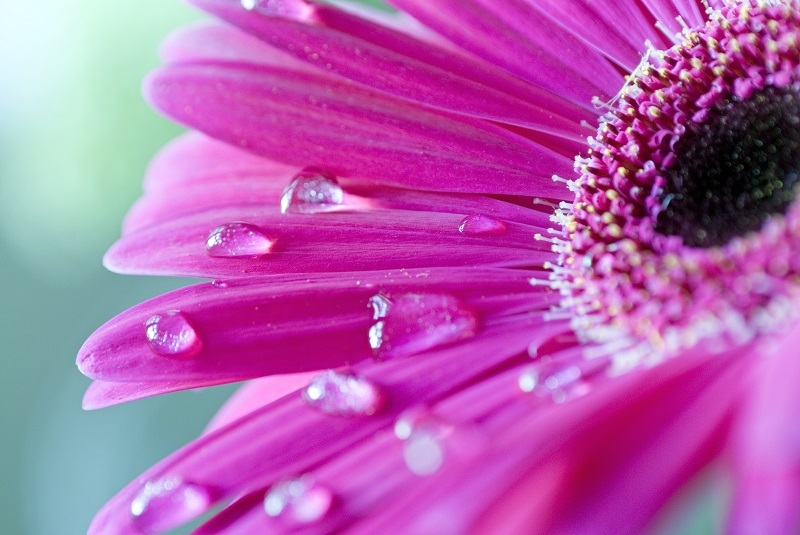Dive Into the Unknown: 8 Fascinating Sunflower Facts
Posted on 23/08/2025
Dive Into the Unknown: 8 Fascinating Sunflower Facts
The humble sunflower is far more intriguing than many realize. From its symbolic meanings to its astounding biology, the sunflower captivates with its beauty, resilience, and scientific oddities. Whether you're a gardener, scientist, or casual nature enthusiast, these facts about sunflowers will make you look at this golden bloom in a completely new light. In this in-depth exploration, we'll dive into eight amazing sunflower facts that will deepen your appreciation for these radiant wonders.
1. Sunflowers Track the Sun: The Mysterious Phenomenon of Helitropism
One of the most recognizable characteristics of sunflowers (Helianthus annuus) is their habit of turning to face the sun--a motion known scientifically as heliotropism. While many people know that young sunflower buds follow the arc of the sun across the sky, fewer realize that this movement is governed by a complex internal clock.
- Young sunflower heads track the sun from east to west during the day.
- At night, they reset by turning back east.
- This movement helps sunflowers maximize photosynthesis and energy intake during their most critical growth stages.
- Mature sunflowers typically stop turning and permanently face east, offering them protection against the harsh midday sun and providing a warmer landing platform that attracts pollinators in the morning.
This sun-chasing phenomenon is unique among large flowering plants, making sunflowers an emblem of beauty, adaptation, and the wonders of nature.

2. Sunflowers Are Built on Mathematical Marvels: The Fibonacci Sequence
Did you know that sunflower seed arrangements are a brilliant example of mathematical perfection? Each sunflower head contains hundreds, sometimes thousands, of seeds arranged in a spiral pattern. These spirals frequently follow the famous Fibonacci sequence, a series of numbers where each number is the sum of the two preceding numbers.
- Most sunflower varieties have 34 spirals in one direction and 55 in the other. Larger sunflowers may have 89 and 144 spirals respectively, all Fibonacci numbers.
- This arrangement enables the seeds to be packed optimally, reducing wasted space and allowing for the maximum number of seeds to fit into the flower head.
- Mathematicians and botanists alike are fascinated by this natural example of efficiency and mathematical beauty.
Next time you gaze at a sunflower, look closely. You'll be seeing a live demonstration of how math shapes the natural world!
3. A Sunflower Is Not Just One Flower--It's Hundreds!
What appears to be a single giant bloom is actually an inflorescence, called a "capitulum," made up of thousands of tiny individual flowers. Here's how sunflowers are structured:
- The outer "petals" are actually called ray florets, which function mainly to attract pollinators with their bright yellow color.
- The center, or flower disk, houses hundreds to thousands of disc florets, each capable of developing into a seed after pollination.
- This composite structure is a hallmark of the sunflower family (Asteraceae), which includes daisies, asters, and chrysanthemums.
This remarkable adaptation ensures that sunflowers are incredibly efficient pollinators, providing rich rewards for bees, butterflies, and other beneficial insects.
4. Sunflowers Have a Rich Cultural and Historical Significance
For centuries, sunflowers have held deep significance in cultures around the world. They're more than just garden favorites--they're emblems of hope, adoration, and abundance. Here are a few highlights of sunflower history:
- Sunflowers were first domesticated over 4,500 years ago in North America by indigenous peoples, who used them for food, medicine, and dyes.
- The sunflower became a symbol of the sun god among ancient Aztecs and was revered for its resemblance to the solar disc.
- In the 18th century, Russian farmers bred sunflower strains with large seeds, jumpstarting the global sunflower oil industry.
- Today, sunflowers often symbolize positivity, loyalty, and spiritual faith in various cultures.
From ancient rituals to modern gardens, the sunflower's rich story reminds us of our shared history with the natural world.
5. Sunflowers Are Eco-Champions: Natural Soil Cleaners
Did you know that sunflowers are used to clean up toxic soils? In a process called phytoremediation, sunflowers can absorb radioactive elements and heavy metals from the ground, helping to restore the environment.
- After the Chernobyl nuclear disaster in 1986 and the Fukushima disaster in Japan, sunflowers were planted to help soak up radioactive contaminants from the soil.
- Sunflowers are also used to extract lead, arsenic, and other heavy metals from polluted soils across the globe.
- This eco-friendly capability makes sunflowers invaluable allies in the fight for environmental recovery and sustainability.
Sunflowers are not only beautiful--they're also powerful agents for healing the Earth.
6. The Edible Bounty: Seeds, Oil, and More
Sunflower seeds are enjoyed worldwide as a delicious nutritious snack and as a vital source of cooking oil. Here's why sunflower products are considered superfoods:
- Sunflower seeds are rich in vitamin E, healthy fats, protein, and essential minerals like magnesium and selenium.
- The seeds can be eaten raw, roasted, or added to salads, granolas, and baked goods for a healthy crunch.
- Sunflower oil, pressed from the seeds, is a staple in many global cuisines and prized for its mild flavor and high smoke point.
- Sunflower petals are also edible and can add color and a slightly nutty flavor to salads and dishes.
From the garden to the kitchen, sunflowers truly provide a versatile bounty for humans and animals alike.
7. Towering Giants: Record-Breaking Sunflower Heights
Sunflowers are famous for reaching astounding heights. While most common varieties grow between 5 and 12 feet tall, some can reach record-breaking statures:
- The tallest sunflower ever recorded stood at an astonishing 30 feet 1 inch (9.17 meters) tall! It was grown by Hans-Peter Schiffer in Germany in 2014 and holds the Guinness World Record.
- Giant sunflower varieties such as the Russian Mammoth and American Giant are popular choices for gardeners aiming for sky-high blooms.
- The rapid vertical growth of these giants is a testament to the sunflower's ability to capture more sunlight and outcompete neighboring plants.
Plant a sunflower in your garden, and you might be amazed by just how tall these botanical wonders can grow!
8. Sunflowers Support Biodiversity and Pollinators
Growing sunflowers in your garden isn't just about beauty--it's also about creating habitats for pollinators and wildlife:
- The vibrant yellow petals of sunflowers attract an array of pollinators including bees, butterflies, and even hummingbirds.
- As the flower heads mature and dry, they provide a valuable food source for birds, particularly finches, as well as small mammals.
- Sunflower pollen is enjoyed by bees and forms a critical component of some bee diets, contributing to healthy pollinator populations.
- Sunflowers can attract beneficial insects that help control pests in vegetable gardens, making them a natural companion plant.
By planting sunflowers, you contribute to the wellbeing of local ecosystems--one seed at a time.
Sunflower Varieties: A Diverse World of Colors and Shapes
When people think of sunflowers, they often picture the classic yellow bloom with a dark brown center. But the world of sunflowers is surprisingly diverse:
- There are over 70 species of sunflowers in the genus Helianthus, ranging from tiny wild varieties to gigantic hybrids.
- Sunflowers aren't always yellow! Some varieties bloom in shades of red, orange, purple, or even creamy white.
- There are branching sunflowers with multiple blooms per plant and dwarf varieties that are perfect for containers.
From wild prairies to formal gardens, the sunflower's versatility means there's a perfect variety for every setting.

How to Grow Your Own Sunflower Success Story
Ready to turn these sunflower facts into action? Here's a quick-step guide for growing magnificent sunflowers in your own garden:
- Choose the Right Location: Sunflowers need full sun--at least six hours per day.
- Plant at the Right Time: Sow seeds after the last frost, when soil is warm.
- Space Seeds Properly: Depending on the variety, space seeds 6 to 24 inches apart.
- Keep Them Fed and Watered: Sunflowers love rich soil and regular water but don't overdo it--good drainage is key.
- Watch for Pests: Protect young seedlings from birds and snails, and support tall varieties against the wind.
- Enjoy the Magic: Stand back and marvel as your sunflowers reach for the sky and attract a buzz of wildlife to your yard!
Conclusion: The Everlasting Allure of Sunflowers
Sunflowers are more than just pretty faces in the garden--they're living marvels of science, history, and ecology. From their daily sun-tracking dances to their mathematical spirals, and from ancient legends to modern-day environmental cleanups, sunflowers hold an enduring fascination that unites people around the world. Not only do these flowers feed bodies and souls, but they also offer hope for a greener planet and a reminder to find joy in the simple wonders of nature.
Next time you encounter a sunflower, take a moment to appreciate its rich legacy and its role in both the natural world and human history. Plant a seed, and watch not just a flower--but a whole ecosystem--flourish.
Frequently Asked Questions About Sunflowers
- How long do sunflowers take to bloom? - Most sunflower varieties bloom within 70 to 100 days of planting seeds.
- Are sunflowers annual or perennial? - Common sunflowers (Helianthus annuus) are annuals, but there are perennial wild sunflower species, too.
- What animals eat sunflowers? - Birds, squirrels, deer, and even people enjoy sunflower seeds. Pollinators love the nectar and pollen!
- Do sunflowers have medicinal uses? - Traditionally, parts of the plant were used by Native Americans for treating wounds, respiratory ailments, and more.
Explore the world of sunflowers and let your curiosity grow as tall as these magnificent blooms!
Latest Posts
Unveiling the Symbolism Behind Peony Flowers and Their Colors
Dive Into the Unknown: 8 Fascinating Sunflower Facts
Explore the 12 Flowers That Stand the Test of Time





